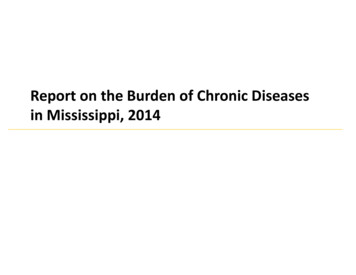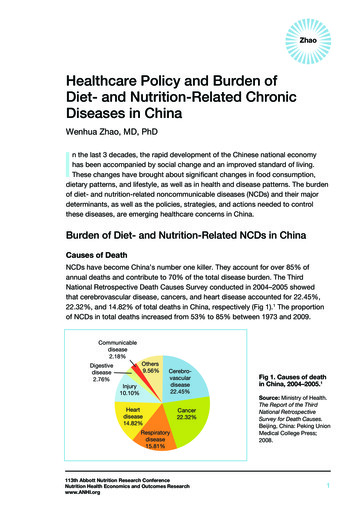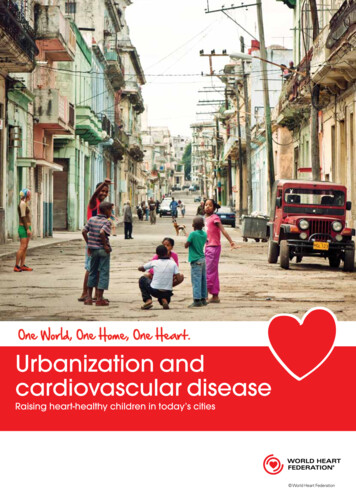
Transcription
Report on the Burden of Chronic Diseasesin Mississippi, 2014
AUTHORVanessa Short, PhD, MPHSenior EpidemiologistMississippi State Department of HealthSeptember 2014ACKNOWLDEGMENTSCassandra Dove, MPHDirector, Chronic Disease BureauMississippi State Department of HealthAmel Mohamed, MPHEpidemiologistMississippi State Department of HealthLatonya Lott, MS, MPHEpidemiologistMississippi State Department of HealthCaroline Newkirk, MPHDirector, Coordinated Chronic DiseasePrevention and Health Promotion ProgramMississippi State Department of HealthRon McAnallyMississippi BRFSS CoordinatorMississippi State Department of HealthVincent Mendy, DrPH, MPH, CPHEpidemiologistMississippi State Department of HealthLarry Smith, PhDEpidemiologistMississippi State Department of HealthVictor Sutton, PhD, MPPADirector, Office of Preventive HealthMississippi State Department of HealthEvelyn Walker, MD, MPHDirector, Office of Health Promotion andHealth EquityMississippi State Department of HealthLei Zhang, PhD, MSc, MBADirector, Office of Health Data and ResearchMississippi State Department of Health
Table of ContentsSectionPage NumberIntroduction7In this Report14List of chronic disease indicators and definitions15Findings/IndicatorsHeart Disease and Stroke21Diabetes29Cancer34Arthritis39Asthma42Oral Health45Nutrition, Physical Activity, and Weight Status49Tobacco and Alcohol Use53Special Section on women of Reproductive Age57Special Section on Youth60Summary and Future Directions66Appendices70Data Sources71Statistical Techniques73List of Abbreviations74References75Burden of Chronic Diseases in Mississippi3
List of Tables and FiguresFigure NumberFigure TitlePage Number1.Leading causes of death in Mississippi, 201182.Hospital discharge rates per 1,000 by disease, Mississippi, 201093.Estimated hospital discharge charges (in millions) by disease, Mississippi, 201094.Projected medical costs for Mississippi for 2010-2020105.Social determinants vary by race in Mississippi136.Percentage of adults with and without self-reported high blood pressure, Mississippi and U.S., 2011227.Percentage of adults with self-reported high blood pressure among subgroups, Mississippi, 2011228.Percentage of adults with and without self-reported high blood cholesterol, Mississippi and U.S., 2011239.Percentage of adults with self-reported high blood cholesterol among subgroups, Mississippi, 20112310.Percentage of adults who did and did not have their blood cholesterol checked within the preceding 5 years, Mississippi and U.S., 20122411.Percentage of adults who had their blood cholesterol checked within the preceding 5 years among subgroups, Mississippi ,20122412.Age-adjusted death rate related to heart disease among subgroups, Mississippi, 20112513.Age-adjusted death rates due to heart disease by county, 2007-20112614.Age-adjusted death rate related to stroke by race and gender, Mississippi, 20102715.Age-adjusted death rates due to stroke by county, 2007-20112816.Percentage of adults with and without self-reported diabetes, Mississippi and U.S., 20123017.Percentage of adults with self-reported diabetes among subgroups, Mississippi, 20123018.Percentage of Mississippi adults with diabetes who have undergone screening tests and the Healthy People 2020 goals for these screening tests3119.Age-adjusted death rate related to diabetes among subgroups, Mississippi, 20103220.Age-adjusted death rates due to diabetes by county, 2007-201133Burden of Chronic Diseases in Mississippi4
List of Tables and FiguresFigure NumberFigure TitlePage Number21.Death rates due to cancer in Mississippi (2010) and the U.S. (2009) and the Healthy People 2020 Goal3522.Age-adjusted death rates due to cancer by county, 2007-20113623.Percentage of adults who have undergone cancer screening tests, Mississippi, 20123724.Incidence rate per 100,000 for late-stage breast, colorectal and cervical cancer, Mississippi and U.S., 2003-20103825.Percentage of adults with and without arthritis, Mississippi and U.S., 20124026.Percentage of adults with arthritis among subgroups, Mississippi, 20124027.Percentage of adults with arthritis who experienced activity limitation, Mississippi and U.S., 20114128.Percentage of adults with arthritis who experienced activity limitation among subgroups, Mississippi, 20114129.Percentage of adults who were and were not ever told that they have asthma, Mississippi and U.S., 20124330.Percentage of adults who were ever told that they have asthma among subgroups, Mississippi, 20124331.Prevalence of asthma attack in the past 12 months among adults with asthma, Mississippi, 20104432.Prevalence of asthma attack in the past 12 months among adults with asthma among subgroups, Mississippi, 20104433.Percentage of adults who visited a dentist of dental clinic within the past year, Mississippi and U.S., 20124634.Percentage of adults who visited a dentist of dental clinic among subgroups, Mississippi, 20124635.Percentage of adults aged 65 years who did and did not have all natural teeth extracted Mississippi and U.S., 20124736.Percentage of adults of adults aged 65 years who had all natural teeth extracted, Mississippi, 20124737.Percentage of adults aged 65 years who did and did not have any teeth extracted, Mississippi and U.S., 20124838.Percentage of adults of adults aged 65 years who had any teeth extracted among subgroups, Mississippi, 20124839.Percentage of adults who reported a normal, overweight or obese BMI, Mississippi and U.S., 20125040.Percentage of adults who are obese among subgroups, Mississippi, 201250Burden of Chronic Diseases in Mississippi5
List of Tables and FiguresFigure NumberFigure TitlePage Number41.Percentage of adults who reported any and no leisure time physical activity, Mississippi, 20125142.Percentage of adults who reported no leisure time physical activity among characteristic, Mississippi, 20125143.Percentage of adults who consume 1 or 1 fruits and vegetables per day, Mississippi, 20115244.Percentage of adults who are and are not current smokers, Mississippi and U.S., 20125445.Percentage of adults who are current smokers among subgroups, Mississippi, 20125446.Percentage of adults who did and did not report binge drinking in the past 30 days, Mississippi and U.S., 20125547.Percentage of adults who reported binge drinking in the past 30 days among subgroups, Mississippi, 20125548.Prevalence of chronic diseases and related risk factors and behaviors among women of reproductive age (18-44 years), Mississippi, 20125849.Prevalence of nutrition, physical activity and weight status related factors and behaviors among Mississippi youth, 20116150.Prevalence of nutrition, physical activity and weight status related factors and behaviors among Mississippi youth by race and gender, 20116251.Prevalence of tobacco and alcohol use among Mississippi youth, 20116352.Prevalence of tobacco and alcohol use among Mississippi youth by race and gender, 201164Burden of Chronic Diseases in Mississippi6
Introduction
Chronic diseases are among the most common of all health problems in Mississippi.In 2011, 7 of the leading causes of death in Mississippi were chronic disease-related. These included deaths with diseases of the heart, cancer, chronic obstructivepulmonary disease, stroke, Alzheimer’s disease, diabetes and kidney disease. Over half (55%) of all deaths in Mississippi were due to cardiovascular-relateddiseases, cancer and diabetes.Figure 1. Leading causes of death in Mississippi, 2011.Diseases of the Heart(25.1% of all deaths)Cancer(21.4% of all deaths)Unintentional injuries(5.8% of all deaths)Chronic obstructive pulmonary disease(5.8% of all deaths)Stroke(5.3% of all deaths)Diabetes mellitus(3.4% of all deaths)Alzheimer's disease(3.3% of all deaths)Kidney diseases(2.3% of all deaths)Influenza/Pneumonia(2.1% of all deaths)0Burden of Chronic Diseases in Mississippi50100150200Age-adjusted death rate per 100,000 population8250300
Chronic diseases are among the most costly of all health problems in Mississippi.In 2010, there were 155,629 (41.2%) discharges due to chronic conditions in Mississippi and the total charges for chronic related conditions was over 4 billion.Congestive heart failure was the most prevalent followed by chronic obstructive pulmonary disease and diabetes mellitus with complications. Myocardial infarction,congestive heart failure and osteoarthritis were the most costly.Figure 2. Hospital discharge rates per 1,000 by disease, Mississippi,2010.Figure 3. Estimated hospital discharge charges (in millions) by disease,Mississippi, 2010.4.5Myocardial Infarction3.8343.293.5354Congestive Heart Failure289Osteoarthritis289Rates per 1,00032.492.522.062.151.61Chronic obstructive pulmonary disease194Diabetes mellitus with complications1891.510.5Stroke1310 0 200 in millionsSource: Hospital Discharge Data Report, 2010Burden of Chronic Diseases in Mississippi9 400
Medical spending on chronic health conditions has grown rapidly in recent years and is placing a significant burdenon state budgets. Medical costs associated with chronic health conditions are expected to continue to increase.Medical costs associated with chronic health conditions are expected to increaseFigure 4. Projected medical costs for Mississippi for 2010-2020.up to 70% between 2010 and 2020. Below is a list of projected percent increasesin medical costs for some of the most common chronic health conditions inMississippi.ConditionProjected % increase in costs, 2010-2020Stroke70.7%Disease of the Heart70.3%Total CVD69.1%Diabetes67.9%Hypertension65.4%Source: Centers for Disease Control and Prevention: Chronic Disease Cost rces/calculator/index.htmBurden of Chronic Diseases in Mississippi10
The prevalence of chronic diseases and related risk factors is generally higher in Mississippi than in other states.Heart Disease andStrokeDiabetes Mississippi's cardiovascular disease death rate is the highest in the nation. Mississippi ranks 2nd in the U.S. for overall diabetes prevalence among adults.Cancer Mississippi had the 2nd highest age-adjusted death rate due to cancer in the nation.Obesity Mississippi ranks 2nd in the U.S. for obesity prevalence among adults.Tobacco Mississippi ranks 6th in the U.S. for overall smoking prevalence among adults.Source: 2013 America’s Health Rankings: www.americashealthrankings.orgBurden of Chronic Diseases in Mississippi11
Chronic diseases are among the most preventable of all health problems in Mississippi.Risk factors for chronic disease may be generally categorized into one of two categories: modifiable and non-modifiable. Four modifiable health riskbehaviors—lack of physical activity, poor nutrition, tobacco use, and excessive alcohol consumption—are responsible for much of the illness, suffering, andearly death related to chronic disease. It has been estimated that if the major risk factors for chronic diseases were eliminated, at least 80% of all heartdisease, stroke and type 2 diabetes, and 40% of all cancer cases would be prevented.Non-modifiableModifiableRisk FactorsRisk FactorsAgeTobacco useAlcohol consumptionPhysical activityGenderDietRaceHigh blood pressureFamily historyHigh cholesterolWeightBurden of Chronic Diseases in Mississippi12
Sociodemographic Snapshot of MississippiSocial determinants of health may influence theburden of chronic burden in Mississippi.Source: 2011 U.S. Census Bureau2,984,926 ResidentsDeterminants of health are factorsA higher percentage of blacks livethat contribute to a person's currentbelow poverty, have less than a highstate of health. These factors may beschool education, are unemployedbiological, socioeconomic,and lack any kind of health carepsychosocial, behavioral, or social incoverage, compared to whites (Figurenature. Social determinants of health5). The demographic profile ofinclude such things as education,Mississippi and the inequalitiesincome, occupation, and access tobetween blacks and whites mayhealth care.influence the chronic disease burden1 in 5 (22%)live below the poverty level(14% in the U.S.)1 in 5 (20%)have less than a high school education(15% in the U.S.)Median Household Income is 38,718(Median Household Income in the U.S. is 52,762)40% of adults are non-white(21.1% in the U.S.)Figure 5. Social determinants vary by race in Mississippi.in the state.Chronic diseases rates are frequently35.7% Living below povertyelevated among socioeconomically12.8disadvantaged groups and someminority populations, including blacks29.2% With less thana high school educationand persons with low incomes and16.8education levels. Mississippi has thehighest percentage of non-whites17.1% Unemployed(40%) among all 50 states and the8.2population is generally poorer andless educated than the rest of the20.8% Without health insurancenation. Further, within Mississippi,15.3Blacksocial determinants of health differbetween racial/ethnic groups.01020Percentage (%)Burden of Chronic Diseases in Mississippi1330White40
In This ReportThis report begins with the description and list of health indicators (healthand other diseases and risk factors. For more information about the CDI,conditions, risk factors, and behaviors) identified as being relevant to publicvisit: http://www.cdc.gov/nccdphp/CDI/overview.htm.health practice and to public health efforts to prevent and control chronicdisease and for which surveillance data were available at the state level.The tables on the following pages list and define the indicators that wereThe bulk of the report details state-level information for each indicator.examined and specifies the data source for each indicator. Results relatedData through the most recent year available and differences betweento each chronic disease domain are organized into eight distinct sectionssubgroups are illustrated. Accompanying each indicator is a discussion ofwithin this report:the importance of the indicator to overall health and highlights of the data,as well as the Healthy People 2020’s National Goal and Target, if available . Heart Disease and Stroke DiabetesMany, but not all , of the health measures were selected based on the CancerIndicators for Chronic Disease Surveillance, which was developed jointly by Arthritisthe Council of State and Territorial Epidemiologists, the Association of Stateand Territorial Chronic Disease Program Directors, and the Centers for AsthmaDisease Control and Prevention (CDC). The Chronic Disease Indicators (CDI) Oral Healthare a cross-cutting set of indicators that were developed by consensus and Nutrition, Physical Activity and Obesitythat allows states, territories and large metropolitan areas to uniformly Tobaccodefine, collect, and report chronic disease data that are important to publichealth practice and available for states, territories and large metropolitanThere are also special sections focusing on chronic diseases in women ofareas . The CDI are divided into eight categories that represent a widereproductive age and youth. Finally, the results are summarized and aspectrum of conditions and risk factors as well as social context, including:discussion is provided. This is followed by a description of the methodsphysical activity and nutrition; tobacco and alcohol use; cancer;and data sources used.cardiovascular disease (CVD); diabetes; arthritis; overarching conditions;Burden of Chronic Diseases in Mississippi14
List of Chronic Disease Indicators, Definitions and Data SourcesSection/IndicatorDefinitionData SourceHeart Disease and StrokeHigh blood pressure awarenessPercentage of adults who report having been told by a health professional of having high blood pressureBRFSSHigh blood cholesterol awarenessPercentage of adults years who report having been told by a health professional of having high blood cholesterolBRFSSCholesterol screeningPercentage of adults aged who report having their cholesterol checked within the previous 5 yearsBRFSSDeaths related to coronary heart diseaseDeaths with ICD-10 codes I11, I20–I25 as the underlying cause of death among residents during a calendar yearMS Vital Statisticsand CDC WonderDeaths related to strokeDeaths with ICD-10 codes I60–I69 as the underlying cause of death among residents during a calendar yearMS Vital Statisticsand CDC WonderDiabetesDiabetes awarenessPercentage of adults who report having been told by a health professional of having diabetes*BRFSSDaily self blood glucose monitoringAdults with self-reported diabetes* who report self-blood glucose monitoring at least once dailyBRFSSDiabetes self management classAdults with self-reported diabetes* who report attending a diabetes self-management classCDC NDSSDaily foot examinationAdults with self-reported diabetes* who report having daily foot examinationsCDC NDSSAnnual foot examinationAdults with self-reported diabetes* who report having received at least one clinical foot examination within the previous yearCDC NDSSAnnual dilated eye examinationAdults with self-reported diabetes* who report having received a dilated eye exam within the previous yearCDC NDSSAnnual hemoglobin A1c examinationAdults with self-reported diabetes* who report having 2 hemoglobin A1c tests in the past yearCDC NDSSDeath related to diabetesDeaths with ICD-10 codes E10–E14 as an underlying or contributing cause of death among residents during a calendar yearNote: All indicators refer to adults 18 years of age unless otherwise noted.Abbreviations: BRFSS Behavioral Risk Factor Surveillance System; CDC Centers for Disease Control and Prevention; ICD International Classification of Diseases; MS Mississippi.;NDSS National Diabetes Surveillance System.* Excluding women who were told only when pregnant.Burden of Chronic Diseases in Mississippi15MS Vital Statisticsand CDC Wonder
List of Chronic Disease Indicators, Definitions and Data SourcesSection/IndicatorDefinitionData SourceCancerCancer (all sites combined), deathDeaths with ICD-10 codes C00–C97 as the underlying cause of death among residents during a calendar yearMS Cancer RegistryCancer of the lung and bronchus, deathDeaths with ICD-10 codes C34 as the underlying cause of death among residents during a calendar yearMS Cancer RegistryCancer of the prostate, deathDeaths with ICD-10 codes C61 as the underlying cause of death among male residents during a calendar yearMS Cancer RegistryCancer of the colon and rectum, deathDeaths with ICD-10 codes C18–C20, C26.0 as the underlying cause of death among residents during a calendar yearMS Cancer RegistryCancer of the female breast, deathDeaths with ICD-10 codes C50 as the underlying cause of death among female residents during a calendar yearMS Cancer RegistryScreening for breast cancerPercentage of women aged 50 years who report having had a mammogram within the previous 2 yearsBRFSSScreening for cervical cancerPercentage of women aged 18 years who report having had a Papanicolaou (Pap) smear within the previous 3 yearsBRFSSScreening for colorectal cancerPercentage of adults 50 years who report having either a fecal occult blood test within the previous year or a sigmoidoscopy orcolonoscopy exam within the previous 5 yearsBRFSSInvasive cancer of the female breast,incidenceIncidence based on ICD-0-3 codes C500-C509 and ICD-0-3 histology (type) excluding 9050-9055, 9140, 9590-9992MS Cancer RegistryInvasive cancer of the colon and rectum,incidenceIncidence based on ICD-0-3 codes C180-C189, C199, C209, C260 and ICD-0-3 histology (type) excluding 9050-9055, 9140, 95909992MS Cancer RegistryInvasive cancer of the cervix,incidenceIncidence based on ICD-0-3 codes C530-C539 and ICD-0-3 histology (type) excluding 9050-9055, 9590-9992MS Cancer RegistryArthritisArthritisPercentage of adults who report having doctor-diagnosed arthritisBRFSSActivity limitation due to arthritisPercentage of adults aged who report doctor-diagnosed arthritis and an activity limitation due to arthritis or joint symptomsBRFSSNote: All indicators refer to adults 18 years of age unless otherwise noted.Abbreviations: BRFSS Behavioral Risk Factor Surveillance System; CDC Centers for Disease Control and Prevention; ICD International Classification of Diseases; MS Mississippi.Burden of Chronic Diseases in Mississippi16
List of Chronic Disease Indicators, Definitions and Data SourcesSection/IndicatorDefinitionData SourceAsthmaEver having asthmaPercentage of adults who were ever told that they have asthmaBRFSSAsthma episode in past 12 monthsPercentage of adults who reported an asthma attack in the past 12 months among adults with asthmaBRFSSVisits to dentist or dental clinicPercentage of adults who report having been to the dentist or dental clinic in the previous yearBRFSSAny teeth extractedPercentage of adults 65 years of age who report having any natural teeth extractedBRFSSAll teeth extractedPercentage of adults 65 years of age who report having all natural teeth extractedBRFSSObesityPercentage of adults who have a body mass index 30.0 kg/m² calculated from self-reported weight and heightBRFSSLeisure time physical activityPercentage of adults who report any leisure time physical activityBRFSSDaily fruit/vegetable consumptionPercentage of adults who report eating fruits and vegetables 1 times/dayBRFSSCurrent smokingPercentage of adults who smoked 100 cigarettes in their lifetime and are current smokers on every day or some daysBRFSSBinge drinkingPercentage of adults who report having 5 drinks (men) or 4 drinks (women) on 1 occasion during the previous 30 daysBRFSSOral HealthNutrition, Physical Activity and ObesityTobacco and Alcohol UseNote: All indicators refer to adults 18 years of age unless otherwise noted.Abbreviations: BRFSS Behavioral Risk Factor Surveillance System; CDC Centers for Disease Control and Prevention; ICD International Classification of Diseases; MS Mississippi.Burden of Chronic Diseases in Mississippi17
List of Chronic Disease Indicators, Definitions and Data SourcesSection/IndicatorDefinitionData SourceSpecial Section on Women of Reproductive AgeAnnual visit to a health care providerPercentage of women aged 18-44 years who report visiting a doctor for a routine checkup in the past yearBRFSSDiabetes/PrediabetesPercentage of women aged 18-44 years who report ever having physician-diagnosed diabetes or prediabetes other than diabetesduring pregnancyBRFSSHigh blood pressurePercentage of women aged 18-44 years who report having been told by a health professional of having high blood pressureBRFSSObesityPercentage of women aged 18-44 years who have a body mass index 30.0 kg/m² calculated from self-reported weight and heightBRFSSCurrent cigarette smokingPercentage of women aged 18-44 years who report having smoked a cigarette on 1 day during the previous 30 daysBRFSSBinge drinkingPercentage of women aged 18-44 years who report having 4 drinks on 1 occasion during the previous 30 daysBRFSSNote: All indicators refer to women 18-44 years of age.Abbreviations: BRFSS Behavioral Risk Factor Surveillance System.Burden of Chronic Diseases in Mississippi18
List of Chronic Disease Indicators, Definitions and Data SourcesSection/IndicatorDefinitionData SourceSpecial Section on YouthOverweightPercentage of students who were 85th percentile but 95th percentile for body mass index*YRBSSObesityPercentage of students who were 95th percentile for body mass index*YRBSSParticipation in physical education classPercentage of students who attended physical education class at least once in an average school weekYRBSSTV viewingPercentage of students who report watching television for more than 3 hours on an average school dayYRBSSComputer usePercentage of students who report playing video or computer games or using a computer for 3 or more hours/day on an averageschool day for something that was not school workYRBSSFruit consumptionFrequency of fruit/100% fruit juice consumption among studentsYRBSSVegetable consumptionFrequency of vegetable consumption among studentsYRBSSEver tried smokingPercentage of students who have ever tried cigarette smokingCurrent cigarette smokingPercentage of students who report having smoked a cigarette on 1 day during the previous 30 daysYRBSSCurrent smokeless tobacco usePercentage of students who report having used smokeless tobacco on 1 day during the previous 30 daysYRBSSEver tried alcoholPercentage of students who have ever tried alcoholCurrent alcohol usePercentage of students who report consumption of 1 drink of alcohol during the past 30 daysYRBSSBinge drinkingPercentage of students who report having 5 drinks of alcohol within a couple of hours on 1 day during the past 30 daysYRBSSNote: All indicators refer to students in grades 9–12.Abbreviations: YRBSS Youth Risk Factor Surveillance System.* Based on sex- and age-specific reference data from the 2000 CDC growth charts.Burden of Chronic Diseases in Mississippi19
Definitions of Demographic and Social Determinants of Health Related VariablesSection/IndicatorDefinitionData SourceSocioeconomic Indicators and Social Determinants of HealthAgeSelf-reported age in yearsBRFSSGenderSelf-reported genderBRFSSRace/ethnicitySelf-reported race/ethnicityBRFSSEducation LevelSelf-reported highest level of education completedBRFSSFederal poverty levelBased on self-reported annual household income and federal guidelines published by Social Security AdministrationHealth care coverageSelf-report having any type of health care coverage (yes, no) among adults 18-64 yearsBurden of Chronic Diseases in Mississippi20BRFSS andU.S. CensusBRFSS
Heart Disease and Stroke Indicators
High blood pressure awareness among adultsHigh blood pressure, also known as hypertension, increases the risk for heart disease and stroke. It is called the "silent killer" because it often has no warningsigns. Lifestyle risk factors for high blood pressure include high sodium intake, excessive caloric intake, physical inactivity, and high alcohol consumption.Healthy People 2020 Goal: Reduce the proportion of adults with high blood pressureHealthy People 2020 Target: 26.9%Figure 6. Percentage of adults with and without self-reported high bloodpressure, Mississippi and U.S., 2011.No high blood pressureHigh blood pressure100Race/Ethnicity and GenderBlack Females90Black Males39.380Percentage (%)Figure 7. Percentage of adults with self-reported high blood pressureamong subgroups, Mississippi, 2011.49.743.3White Females30.831.3White Males70605035.8Education Level High School41.5High School41.1 High School4060.73034.7Federal Poverty Level (FPL)69.20-99% FPL49.1100-199% FPL2047.1200-299% FPL1035.8 300% FPL0Mississippi32.60U.S.102030405060Age-adjusted percentage (%)2011 DATA HIGHLIGHTS 4 out of 10 adults in Mississippi reported high blood pressure. Adults with more than a high school education had a lower prevalence ofhigh blood pressure than those with a high school education or less. Black females had the highest prevalence of high blood pressure. The prevalence of high blood pressure increased as poverty increased. Thoseliving at 0-99% FPL had a 66% higher prevalence of high blood pressure thanthose living at 300% FPL. A higher proportion of blacks reported high blood pressure than whites.Burden of Chronic Diseases in Mississippi22
High blood cholesterol awareness among adultsHigh blood cholesterol is one of the major modifiable risk factors for heart disease and stroke. As a results, public health agencies and their partners haveattempted to reduce the prevalence of high blood cholesterol through screening and by increasing public awareness of high blood cholesterol and strategies forreducing it. Cholesterol levels can be reduced through dietary changes (e.g., reduced intake of saturated fats and dietary cholesterol), increased physicalactivity, and drug treatment.Figure 8. Percentage of adults with and without self-reported high bloodcholesterol, Mississippi and U.S., 2011.No high cholesterolHigh cholesterol100Race/Ethnicity and GenderBlack Females35.990Black Males35.280Percentage (%)Figure 9. Percentage of adults with self-reported high blood cholesterolamong subgroups, Mississippi, 2011.42.3White Females38.437.9White Males7035.9Education Level High School60504034.1High School39.1 High School39.4Federal Poverty Level (FPL)3057.861.60-99% FPL201046.2100-199% FPL37.3200-299% FPL37.3 300% FPL0Mississippi35.40U.S.1020304050Age-adjusted percentage (%)2011 DATA HIGHLIGHTS More than 40% adults in Mississippi reported high blood cholesterol. There were no significant differences by gender, race, or level of education. Those living at 0-99% FPL had a higher prevalence of high blood cholesterolthan those living at 300% FPL.Burden of Chronic Diseases in Mississippi23
Cholesterol screening among adultsHigh cholesterol usually has no signs or symptoms, however, a simple blood test can tell a person’s cholesterol level. The National Cholesterol EducationProgram recommends that healthy adults get their cholesterol levels checked every five years.Healthy People 2020 Goal: Increase the percentage of adults aged 18 years and older had their blood cholesterol checked within the preceding 5 yearsHealthy People 2020 Target: 82.1%Figure 10. Percentage of adults who did and did not have their cholesterolchecked within the preceding 5 years, Mississippi and U.S., 2012.CheckedFigure 11. Percentage of adults who had their cholesterol checked within thepreceding 5 years among subgroups, Mississippi, 2012.Not checked100Race/Ethnicity and GenderBlack Females90Black Males94.8White Females94.3White Males94.928.724.5Percentage (%)807097.9Education Level High School60504071.375.591.4High School95.2 High School96.4Federal Poverty Level (FPL)300-99% FPL20100-199% FPL94.4200-299% FPL95.51091.6 300% FPL0Mississippi97.80U.S.10 20 30 40 50 60 70 80 90 100Age-adjusted percentage (%)2012 DATA HIGHLIGHTS Just over 70% of adults in Mississippi had their b
Death rates due to cancer in Mississippi (2010) and the U.S. (2009) and the Healthy People 2020 Goal 35 22. Age-adjusted death rates due to cancer by county, 2007-2011 36 23. Percentage of adults who have undergone cancer screening tests, Mississippi, 2012 37 24. Incidence rate per 100,000 for late-stage breast, colorectal and cervical cancer .











